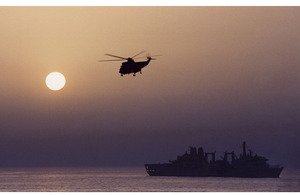Navy team boards and destroys pirate ship
A Royal Fleet Auxiliary vessel, deployed as part of an international naval task force operating in the Somali Basin, has located, boarded and destroyed a pirate vessel found to be carrying assault rifles and rocket-propelled grenades.

A Fleet Air Arm helicopter flies over RFA Fort Victoria (stock image) [Picture: Leading Airman (Photographer) Angie Pearce, Crown Copyright/MOD 2003]
RFA Fort Victoria, under the command of Captain Rob Dorey, part of Task Group 151.2, was conducting routine counter-piracy operations off the Somali coast with its embarked 820 Naval Air Squadron Merlin helicopter when a whaler with a skiff (small fishing craft) in tow was spotted at anchor.
When the helicopter approached the whaler, four of the suspected pirates tried to hide, leaving the remaining five in view. This and the fact that there were 12 barrels of fuel onboard and the vessel was towing a skiff aroused suspicion that this may be a Pirate Action Group (PAG).
Permission was granted by the Coalition Task Force Commander and the UK Maritime Component Commander to close the suspected pirate vessel and board. Royal Marines from the Fleet Protection Group, who provide the boarding teams for the current counter-piracy surge (Operation CAPRI), took to their boats and, with the helicopter and Royal Marine snipers in support, approached the whaler.
The suspected pirates attempted to make a break for shore when they saw the approaching boats but, being no match for the high-powered rigid inflatable boats and armoured offshore raiding craft, was surrounded within seconds.
Once aboard the suspected pirate vessel, a search revealed six AK-variant assault rifles and a rocket-propelled grenade (RPG) launcher with four warheads and six RPG booster charges. Also found were two hand-held global positioning systems, three makeshift ladder sections and four mobile phones.
The decision was made to destroy the whaler and permanently disable the brand new outboard motor on the skiff (which was out of fuel in any case). The nine suspected pirates were transferred to the skiff and dispatched towards the shore line with oars. Once the suspected pirates were safely ashore the main pirate vessel was rigged with explosives.
At 2300hrs local time, the vessel and other pirate paraphernalia lit up the night sky in a loud explosion as Colour Sergeant Aston blew the pirate boat to smithereens, witnessed by the proud ship’s company.
This would have been a costly loss for the suspected pirates and the people who finance them. The PAG was almost certainly in the final phase of preparing to head out to sea in search of its next target, so disrupting this activity and denying the potential pirates their expensive equipment may well have saved a ship from being attacked and will have sent a clear message to the pirate community.
Colonel Mark Gray Royal Marines, Commander of the Op CAPRI Task Group (which also includes the frigate HMS Northumberland), added:
Contrary to the Hollywood legend, there is nothing romantic about pirates and piracy. It is a blight which has struck the shores of Somalia and strikes at the very heart of the UK’s national interest [99 per cent of our imports travel by sea].
Countering piracy is one of the Royal Navy’s historical roles and even today it is a vital one. One cannot help a schoolboy grin at the sight of a bunch of chastened pirates being deposited on shore, tails between their legs and the tools of their trade disappearing with a loud boom and a flash of flame.
CTF-151 is one of three task forces operated by Combined Maritime Forces, a 25-nation coalition based in Bahrain. Its main focus areas are defeating terrorism, preventing piracy, reducing illegal activities and promoting a safe maritime environment. In conjunction with NATO and the EU Naval Force, ships from CTF-151 patrol in the Somali Basin and the Internationally Recommended Transit Corridor in the Gulf of Aden. CTF-151 also helps promote to the shipping community best management practice methodology for the avoidance of piracy.